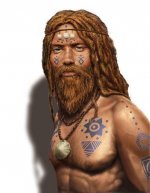Alan
Elite member
- Messages
- 2,517
- Reaction score
- 450
- Points
- 0
- Ethnic group
- Kurdish
- Y-DNA haplogroup
- R1a1a1
- mtDNA haplogroup
- HV2a1 +G13708A
Thank you Angela for the ref; even so, as the 2015 paper with 1180 mtDNA didn't found any M52 I looked at the sources of the paper that you add; the paper finds 9 cases of M52 among 472 Indian Muslims (2%), but everybody will guess that this pop is not the best to know ancient mtDNA... and such high number is in fact more an orange alarm than other thing; for the Indian non-Musliams they have got 796 mtDNA samples from a 2004 paper, 752 from a 2003 paper and 550 from a 1999 paper (total 2098), they don't give the numbers of Indian M52 found neither Tharu M52, but the M52 Tharus are... one case among 472 samples. So it's a big deal to say that M52 is "frequent"... what would be the case if per example we would sample 3000 Iranians? I think that the biased data by the number of samples taken in each pop could point another history.
I had critized this approach on various Haplogroups such as yDNA R2 already. On the WIkipedia page some people wrote R2 "originated" in India because the highest number of R2 individuals has been found there, not realizing that naturally you will find higher number of one Haplogroup in a population of a billion people in comparison to a population with maybe 10-100 million. With other words it doesn't really matter how high the number/frequency is, especially in India where Caste Systems play a huge role and end up in high Frequencies in single Haplogroups (Founder effect).
As I said I personally don't believe M originated in India just out of the logic that M is the sister clade of N and M if found both in India, as well North Africa what makes an origin inbetween most likely IMO. I think M has been moved around by Neolithic farmers/herders both to India as well North Africa. But I could be wrong and it is possible that there is an ancient South Asian contribution into West Asia. As we know there is interaction between South_Central Asia and West Asia from ancient times.


